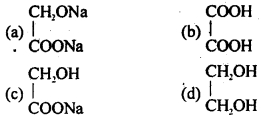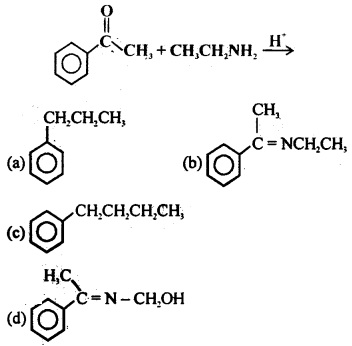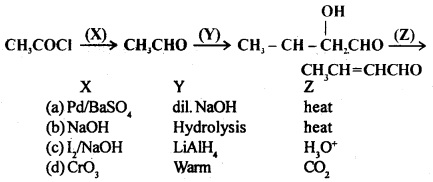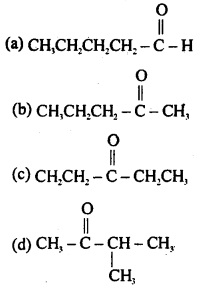CBSE Class 12 Chemistry – MCQ and Online Tests – Unit 12 – Aldehydes, Ketones and Carboxylic Acids
Every year CBSE conducts board exams for 12th standard. These exams are very competitive to all the students. So our website provides online tests for all the 12th subjects. These tests are also very effective and useful for those who preparing for competitive exams like NEET, JEE, CA etc. It can boost their preparation level and confidence level by attempting these chapter wise online tests.
These online tests are based on latest CBSE Class 12 syllabus. While attempting these our students can identify the weak lessons and continuously practice those lessons for attaining high marks. It also helps to revise the NCERT textbooks thoroughly.
CBSE Class 12 Chemistry – MCQ and Online Tests – Unit 12 – Aldehydes, Ketones and Carboxylic Acids
Question 1.
Aldehydes other than formaldehyde react with Grignard’s reagent to give addition products which on hydrolysis give
(a) tertiary alcohols
(b) secondary alcohols
(c) primary alcohols
(d) carboxylic acids
Answer
Answer: (b) secondary alcohols
Question 2.
Which of the following will not give aldol condensation?
(a) Phenyl acetaldehyde
(b) 2-Methylpentanal
(c) Benzaldehyde
(d) 1-Phenylpropanone
Answer
Answer: (c) Benzaldehyde
Question 3.
Which of the following compounds will ive a coloured crystalline compound with
(a) CH3COCl
(b) CH3COOC2H5
(c) CH3COCH3
(d) CH3CONH2
Answer
Answer: (c) CH3COCH3
Question 4.
The oxidation of toluene to benzaldehyde by chromyl, chloride is called
(a) Etard reaction
(b) Riemer-Tiemann reaction
(c) Wurtz reaction
(d) Cannizzaro’s reaction
Answer
Answer: (a) Etard reaction
Question 5.
Study the given reaction and identify the process which is carried out
(a) It is used for purification of aldehydes and ketones
(b) It is used to distinguish aldehydes from ketones
(c) It is used to prepare cyclic aldehydes and ketones
(d) It is used to study polar nature of aldehydes and ketones
Answer
Answer: (a) It is used for purification of aldehydes and ketones
Question 6.
The addition of HCN to carbonyl compounds is an example of
(a) nucleophilic addition
(b) electrophilic addition
(c) free radical addition
(d) electromeric addition
Answer
Answer: (a) nucleophilic addition
Question 7.
Which of the following compounds does not react with NaHSO3?
(a) HCHO
(b) C6H5COCH3
(c) CH3COCH3
(d) CH3CHO
Answer
Answer: (b) C6H5COCH3
Question 8.
Identify reactant (X) in the given reaction sequence
(a) CH3MgCl
(b) CH3COCl +Mg
(c) MgCl2
(d) CH3CH2MgCl
Answer
Answer: (a) CH3MgCl
Question 9.
Propanone can be prepared from ethyne by
(a) passing a mixture of ethyne and steam over a catalyst, magnesium at 420°C
(b) passing a mixture of ethyne and ethanol over a catalyst zinc chromite
(c) boiling ethyne with water in the presence of HgSO4 and H2SO4
(d) treating ethyne with iodine and NaOH
Answer
Answer: (c) boiling ethyne with water in the presence of HgSO4 and H2SO4
Question 10.
Which of the following compounds will undergo Cannizzaro reaction?
(a) CH3CHO
(b) CH3COCH3
(c) C6H5CHO
(d) C6H5CH2CHO
Answer
Answer: (c) C6H5CHO
Question 11.
The best oxidising agent- for oxidation of
CH3-CH = CH-CHO to CH3-CH = CH-COOH is
(a) Baeyefs reagent
(b) Tollen’s reagent
(c) SchifFs reagent
(d) Acidified dichromate
Answer
Answer: (b) Tollen’s reagent
Question 12.
There is a large difference in the boiling points of butanal and butanal-1-oldueto
(a) intermolecular hydrogen bonding in butan-1-ol
(b) intermolecular hydrogen bonding in butanal
(c) higher molecular mass of butan-1-ol
(d) resonance shown by butanal
Answer
Answer: (a) intermolecular hydrogen bonding in butan-1-ol
Question 13.
Benzoyl Chloride on reduction with H2/Pd-BaSO4 produces
(a) benzoic acid
(b) benzyl alochol
(c) benzoyl sulphate
(d) benzaldehyde
Answer
Answer: (d) benzaldehyde
Question 14.
Which of the following does not undergoCannizzarro’s reaction?
(a) Benzaldehyde
(b) 2-Methylpropanal
(c) p-Methoxybenzaldehyde
(d) 2, 2-Dimethylpropanal
Answer
Answer: (b) 2-Methylpropanal
Question 15.
Aldehydes that do not undergo aldol condensation are
1. propanal
2. trichloroethanal
3. 2-phenylethanal
4. fethanal
5. benzaldehyde
(a) 3 and 4 only
(b) 2 and 5 only
(c) 1, 2 and 3 only
(d) 2, 3 and 5 only
Answer
Answer: (b) 2 and 5 only
Question 16.
α-Hydroxypropanoic acid can be preapred from ethanal by following the steps given in the sequence
(a) Treat with HCN followed by acidic hydrolysis
(b) Treat with NaHSO3 followed by reaction with Na2CO3
(c) Treat with H2SO4 followed by hydrolysis
(d) Treat with K2Cr2O7 in presence of sulphuric acid
Answer
Answer: (a) Treat with HCN followed by acidic hydrolysis
Question 17.
In the following sequence of reaction, the final product (Z) is![]()
(a) ethanal
(b) propan-2-ol
(c) propanone
(d) propan-2-ol
Answer
Answer: (c) propanone
Question 18.
Hydrocarbons are formed when aldehydes and ketones are reacted with amalgamated zinc and conc. HCl. The reaction is called
(a) Cannizzaro reaction
(b) Clemmensen reduction
(c) Rosenmund reduction
(d) Wolff-Kishner reduction
Answer
Answer: (b) Clemmensen reduction
Question 19.
What is the test to differentiate between penta-2-one and pentan-3-one?
(a) Iodoform test
(b) Benedict’s test
(c) Fehling’s test
(d) Aldol condensation test
Answer
Answer: (a) Iodoform test
Question 20.
The final product (Y) in the following sequence of chemical reaction is![]()
(a) An alkene
(b) a carboxylic acid
(c) an aldehyde
(d) sodium salt of carboxylic acid
Answer
Answer: (d) sodium salt of carboxylic acid
Question 21.
When propanal reacts with 2-methylpropanal in presence of NaOH, four different products are formed. The reaction is known as
(a) Aldol condensation
(b) Cross aldol condensation
(c) Cannizzaro reaction
(d) HVZ condensation
Answer
Answer: (b) Cross aldol condensation
Question 22.
In order of reactivity of CH3CHO, CH3COC2H5 and CH3COCH3 is
(a) CH3CHO > CH3COCH3 > CH3COC2H5
(b) C2H5COCH3 > CH3COCH3 > CH3CHO
(c) CH3COCH3 > CH3CHO > C2H5COCH3
(d) CH3COCH3 > C2H5COCH3 > CH3CHO
Answer
Answer: (a) CH3CHO > CH3COCH3 > CH3COC2H5
Question 23.
Which of the following reagents are not correctly matched with the reaction?
(a) CH3CH = CHCHO → CH3CH = CHCOOH : Ammoniacal AgNO3
(b) CH3CH = CHCHO → CH3CH = CHCH2OH : H2/Pt
(c) R-COOH → R-CH2CH : NaBH4
(d) CH3CH2COCl → CH3CH2CHO : H2Pd/BaSO4
Answer
Answer: (b) CH3CH = CHCHO → CH3CH = CHCH2OH : H2/Pt
Question 24.
Which among the following is most reactive to give nucleophilic addition?
(a) FCH2CHO
(b) ClCH2CHO
(c) BrCH2CHO
(d) ICH2CHO
Answer
Answer: (a) FCH2CHO
Question 25.
The product (X) will be
Answer
Answer: (c)
Question 26.
The product of hydrolysis of ozonide of 1-butene are
(a) ethanol only
(b) ethanal and methanal
(c) propanal and methanal
(d) methanal only
Answer
Answer: (c) propanal and methanal
Question 27.
Find the product of the given reaction
Answer
Answer: (b)
Question 28.
Fill in the reagents for the given conversation:
Answer
Answer: (a)
Question 29.
Which of the following is the most.reactive isomer?
Answer
Answer: (a)
Question 30.
Which of the following compound will undergo self aldol condensation in the presence of cold dilute alkali?
(a) CH ≡ C-CHO
(b) CH2 = CHCHO
(c) C6H5CHO
(d) CH3CH2CHO
Answer
Answer: (d) CH3CH2CHO
Question 31.
To differentiate between pentan-2-one and penta-3-one a test is carried out. Which of the following is the correct answer?
(a) Pentan-2-one will give silver mirror test
(b) Pentan-2-one will give iodoform test
(c) Pentan-3-one will give iodoform test
(d) None of these
Answer
Answer: (b) Pentan-2-one will give iodoform test
Question 32.
Which compound is obtained when acetaldehydes are treated with dilute solution of caustic soda?
(a) Sodium acetate
(b) Resinous mass
(c) Aldol
(d) Ethyl acetate
Answer
Answer: (c) Aldol
Question 33.
Which of the following reactions will give benzolphenone?
(i) Benzoyl chloride + Benzene + AlCl3
(ii) Benzoyl chloride + Phenylmagnesium bromide
(iii) Benzoyl chloride + Diphenyl cadmium
(a) (i)and(ii)
(b) (ii) and (iii)
(c) (i) and (iii)
(d) (i), (ii) and (iii)
Answer
Answer: (c) (i) and (iii)
Question 34.
Identify the products (X) and (Y) in the given reaction
(a) X = Acetophenone, Y = m-N itroacetophone
(b) X = Toluene, Y = m-Nitroacetotoluene
(c) X = Acetophenone, Y = o- and p-Dinitroacetophenone
(d) X = Benzaldehyde, Y = m-Nitrobenzaldehyde
Answer
Answer: (a) X = Acetophenone, Y = m-N itroacetophone
Question 35.
Which of the following does not answer iodoform test?
(a) n-Butyl alcohol
(b) sec-Butyl alcohol
(c) Acetophenone
(d) Acetaldehyde
Answer
Answer: (a) n-Butyl alcohol














0 Comments:
Post a Comment